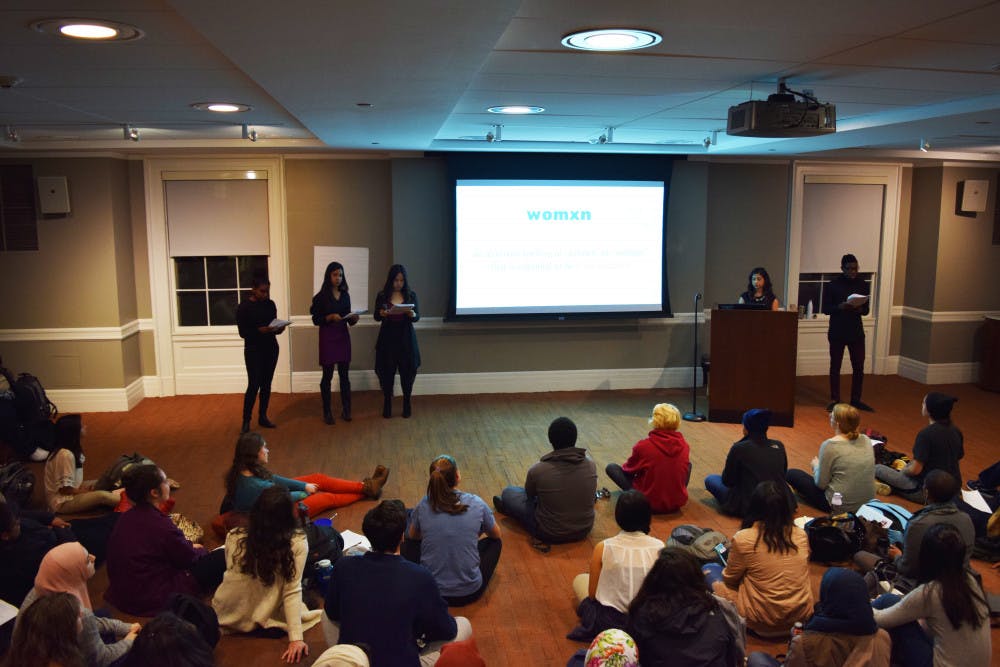Minority Peer Counselors held their first workshop on sexism this semester titled “Ain’t I A Womxn? Women, Redefined” in Petteruti Lounge Monday night.
The workshop, facilitated by MPCs Maryam Ahmad ’19, Shanzé Tahir ’19, Salina Tesfay ’19, Terrell Palmer ’19 and Julie Pham ’19, aimed to examine sexism within our society and support the resilience of womxn’s marginalized voices.
The alternate spelling, womxn, for “women” and “woman” is trans-inclusive, in contrast to the alternate spellings “womyn” and “wombyn,” which is rooted in transphobia, though both alternate spellings are aimed at avoiding patriarchal suffixes, the facilitators said.
The facilitators began by defining sexism as “a system of oppression that devalues womxnhood and femininity to privilege men and masculinity” and explained how cissexism devalues many people who identify with femininity.
Following a roadmap of the womxn’s “body, hands, mind and soul,” the facilitators guided the audience through various forms of oppression faced by womxn. They also underscored the additional layers of challenges faced by womxn of color and trans womxn.
The “body” section of the presentation centered on the politicization and policing of womxn’s bodies.
“Politicization refers to the ways in which the media, popular culture and political authorities use womxn’s bodies as tools to further political or ideological agendas,” Tesfay said.
The Burkini Ban in France was used as a case study for how Muslim womxn’s bodies are politicized. It also served as a basis for the presenters’ definition of intersectionality, which they referred to as the way that sexism and other systems of oppression can be compounded by unique configurations of various facets of identity such as gender, nationality, ability, sexuality and racial identity.
In American society, trans womxn’s bodies are dehumanized “to the point where politicians feel entitled to make laws determining which bathrooms trans womxn can or can’t use,” Ahmad said.
The facilitators also focused on the way black womxn’s bodies are policed. They quoted Moya Bailey, a black queer feminist, who coined the term “misogynoir” to describe “the intersection of racism, anti-blackness and misogyny that black womxn and femme-identifying (people) experience.”
The “hands” section of the presentation examined the work of womxn and how the successes of womxn are often attributed to men. These successes often go unrecognized or uncompensated, especially for womxn of color.
Chien-Shiung Wu and Simone Biles were given as two examples of womxn of color who were devalued despite their successes. Wu was a Chinese physicist whose contributions helped two male theoretical physicists win a Nobel Prize without any acknowledgment of her help. Simon Biles, an Olympic gymnast, is often referred to as “the Kobe Bryant of gymnastics.”
“These examples depict how womxn of color achievements are often only validated when compared to men’s accomplishments,” Tesfay said.
In addition to this erasure of accomplishments, womxn often have to take on emotional labor as well.
“Emotional labor is providing emotional support and empathy without reciprocation or acknowledgement and disproportionally falls to womxn, especially womxn of color,” Tesfay said. This concept is based on stereotypes, such as that womxn are “weak” and should stick to household labor.
The third section, “mind,” focused on the mental health of womxn of color. The facilitators showcased the evocative art of Kristy Latoya Peters, a black painter, whose art reflects her own mental health experiences as a black womxn and serves as a form of activism.
In a group discussion, audience members pointed out ways in which certain groups of womxn could be barred from access to help for mental health. This includes stigma about seeking mental assistance and the challenge of affording mental health care.
Womxn often face difficulties while navigating emotions in the public sphere, the facilitators said. Michelle Obama was given as an example of someone who has wondered about appearing too loud or angry as a womxn.
“Michelle Obama’s experience is a manifestation of the difficulty many womxn of color face when navigating their emotions and being forced to internally police themselves,” Tahir said.
The final section, “soul,” examined the resilience of womxn and re-evaluated common ideas of resistance.
Mainstream feminism portrays empowered womxn as being tough, not shaving and not wearing makeup as a means of rebelling against patriarchial ideas of femininity, the facilitators said. But this representation fails to account for many womxn who shave and wear makeup for reasons other than for men.
“Trans womxn, especially trans womxn of color, face disproportionate amounts of violence. As a result, for some trans womxn, makeup and shaving can be a means of passing and avoiding harassment and violence,” Palmer said.
The facilitators then showcased various forms of resistance and resilience against racism and sexism. One form is womanism, which “identifies and critically analyzes sexism, anti-black racism and their intersection,” Tahir said. It especially recognizes the beauty and strength of black womanhood.
They then showed an image of the 1968 Pembroke Walkout as another form of resistance.
“Brown University womxn left campus in protest of a lack of institutional support for black students,” Pham said. “This illustrates the legacy of activism among black womxn on Brown’s campus and how black womxn are often at the head of movements that impact the entire black community.”





